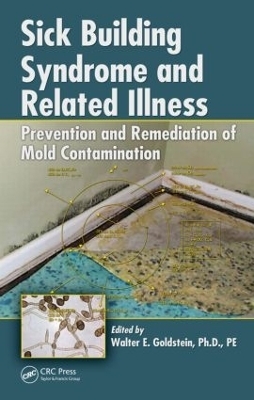
Sick Building Syndrome and Related Illness
Prevention and Remediation of Mold Contamination
Seiten
2010
Crc Press Inc (Verlag)
978-1-4398-0144-4 (ISBN)
Crc Press Inc (Verlag)
978-1-4398-0144-4 (ISBN)
- Titel z.Zt. nicht lieferbar
- Versandkostenfrei innerhalb Deutschlands
- Auch auf Rechnung
- Verfügbarkeit in der Filiale vor Ort prüfen
- Artikel merken
Focuses on the serious contaminants that cause fungal infestations, commonly referred to as mold. This book provides information on how to counter problems as they occur and how to prevent infestations with proactive measures. It includes chapters on biology and metrics that explore how to approach measuring infestation and understanding it.
Small but mighty, ranging from 3 to 100 microns in size, miniscule mold organisms can cause big problems. A seemingly minor water leak behind a wall, unnoticed until the sinister color of mold is evident, can wreak havoc and cause a financial nightmare. A practical primer, Sick Building Syndrome and Related Illness: Prevention and Remediation of Mold Contamination focuses on the serious contaminants that cause fungal infestations, commonly referred to as mold. It examines how to counter problems as they occur and how to prevent infestations with proactive measures.
The book sets the stage with a general introduction and then explores the matter in terms of health care and epidemiology. It covers mold genetics and biology, explains the negative health consequences of mold products and by-products, and supplies examples of possible treatments. The editor includes coverage of metrics and explores how to approach measuring infestation and understanding it. The chapter on epidemiology conveys an understanding of the problem and its magnitude and details aspects of health challenges. The book also discusses mold and other contaminant particles, remediation, and repair to provide insight on what to do in the event of a problem. It details a model for mold growth that can be used to prevent such growth, equations of mold growth and product formation, and analytical developments and sampling techniques.
Better materials science and the ability to know when mold will occur and how to prevent it and remediate it are critical and key remedies to mold infestation. Sound science and engineering can be incorporated as a package as part of a home or commercial buyer’s purchase. For example, the model for mold growth presented in this book can be adapted commercially to depict how mold growth can occur and how to prevent such growth, making it useful in building design, mold prevention, and directing research to new solutions.
Small but mighty, ranging from 3 to 100 microns in size, miniscule mold organisms can cause big problems. A seemingly minor water leak behind a wall, unnoticed until the sinister color of mold is evident, can wreak havoc and cause a financial nightmare. A practical primer, Sick Building Syndrome and Related Illness: Prevention and Remediation of Mold Contamination focuses on the serious contaminants that cause fungal infestations, commonly referred to as mold. It examines how to counter problems as they occur and how to prevent infestations with proactive measures.
The book sets the stage with a general introduction and then explores the matter in terms of health care and epidemiology. It covers mold genetics and biology, explains the negative health consequences of mold products and by-products, and supplies examples of possible treatments. The editor includes coverage of metrics and explores how to approach measuring infestation and understanding it. The chapter on epidemiology conveys an understanding of the problem and its magnitude and details aspects of health challenges. The book also discusses mold and other contaminant particles, remediation, and repair to provide insight on what to do in the event of a problem. It details a model for mold growth that can be used to prevent such growth, equations of mold growth and product formation, and analytical developments and sampling techniques.
Better materials science and the ability to know when mold will occur and how to prevent it and remediate it are critical and key remedies to mold infestation. Sound science and engineering can be incorporated as a package as part of a home or commercial buyer’s purchase. For example, the model for mold growth presented in this book can be adapted commercially to depict how mold growth can occur and how to prevent such growth, making it useful in building design, mold prevention, and directing research to new solutions.
Goldstein Consulting Company, Las Vegas, Nevada, USA
Introduction. Epidemiology and Health Effects in moisture-damaged Damp Buildings. Mold Biology, Molecular Biology, and Genetics. Products of Mold and Other Entities. Mathematical Model of Mold Propagation and Product formation in building materials, inherent transport phenomena, and Applications. Forensic Studies in Moldy-Damp Buildings. Practices in Identifying, Remediating, and "Put Back" When Mold Occurs. Analysis of Microscopic Contaminants in Sick Building Investigations. Analytical Practice in Mold Identification and Solutions, Including Measurements and Sampling. Research and Development, Directions in Construction Practice, and Summary Recommendations.
| Erscheint lt. Verlag | 24.8.2010 |
|---|---|
| Zusatzinfo | 15 Tables, black and white; 18 Illustrations, color; 84 Illustrations, black and white |
| Verlagsort | Bosa Roca |
| Sprache | englisch |
| Maße | 156 x 234 mm |
| Gewicht | 589 g |
| Themenwelt | Medizin / Pharmazie ► Medizinische Fachgebiete ► Arbeits- / Sozial- / Umweltmedizin |
| Studium ► Querschnittsbereiche ► Epidemiologie / Med. Biometrie | |
| Naturwissenschaften ► Chemie ► Technische Chemie | |
| Technik ► Bauwesen | |
| Technik ► Umwelttechnik / Biotechnologie | |
| ISBN-10 | 1-4398-0144-4 / 1439801444 |
| ISBN-13 | 978-1-4398-0144-4 / 9781439801444 |
| Zustand | Neuware |
| Informationen gemäß Produktsicherheitsverordnung (GPSR) | |
| Haben Sie eine Frage zum Produkt? |
Mehr entdecken
aus dem Bereich
aus dem Bereich
ein überfälliges Gespräch zu einer Pandemie, die nicht die letzte …
Buch | Hardcover (2024)
Ullstein Buchverlage
24,99 €


